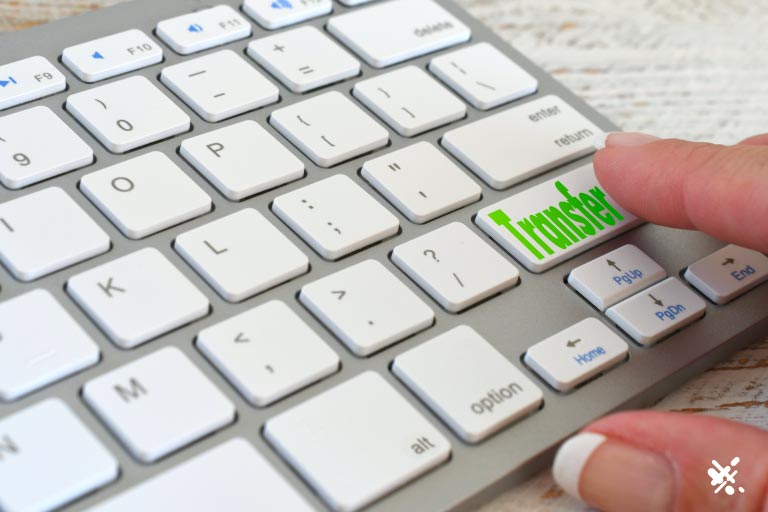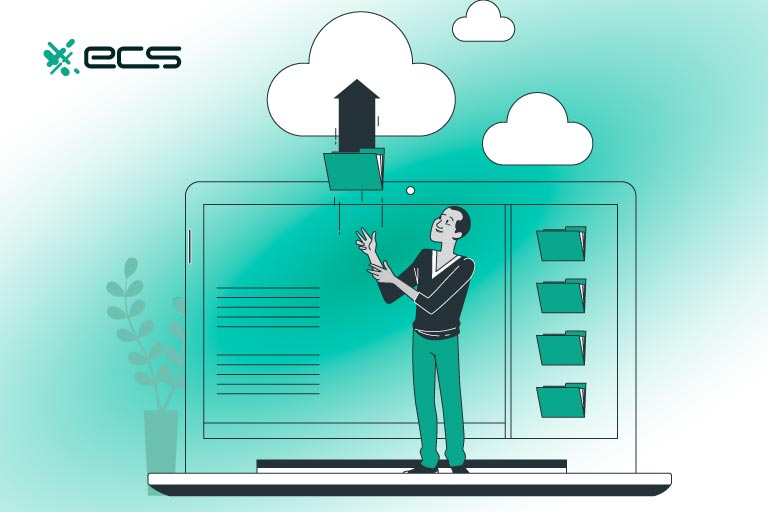Anything with an “e” in front of it signifies something electronic. eCommerce is all about shopping online. eDating is all about meeting creepy people from the comfort of your phone. And eCheck payments are all about using one of the world’s oldest forms of payment…electronically.
You might be wondering why consumers would want to use eChecks when they can just pay for things with debit and credit cards. From your end (the business owner), eChecks provide some significant advantages over plastic payments, especially for big-ticket items or recurring payments (like subscriptions).
A Short History of eCheck Payments
The first eCheck was issued in 1998 by the federal government, which paid an Air Force contractor $32,000 for a project. In the 25 or so years since then, eChecks have entered the retail payment landscape. Of course, before eChecks, there were paper checks. And before then, there was cash.
Once upon a time, everyone paid for everything in cash. Around the middle ages, certain groups spread out over Europe and the Mediterranean, creating a trusted network of financiers. One such group was a crusading order known as the Knights Templar.
You could pick up a piece of paper from a knight in England and collect money from a different knight in Acre. A banking system of paper checks was born.
Checks have certainly advanced since then, but in recent times, check usage has declined. Most consumers prefer debit and credit card payments over checks, and merchants do as well.
A business owner has to deposit a traditional paper check in their checking account. Then there will be processing time for the transfer of funds. When all is said and done, paper checks are time-consuming and expensive.
Do Consumers Like Checks?
Consumers writing checks feel the same way. Financial institutions in the United States have taken note of preferred payment methods for consumer-facing transactions. The preferred method is plastic, both in-person and online. In fact, around 45% of Americans didn’t write a single check in 2022.
Checks are only used for about 7% of transactions—however, checks have a high average dollar amount of $300. Compare this to cash transactions ($22) and card transactions ($112). This tells us that checks are not typically used for smaller, everyday transactions. Rather, they are used for larger one-off payments like a home repair, or recurring payments like bills.
Your business would do well to accept eChecks or electronic checks. As it turns out, even though eChecks have some of the same back-end processes as paper checks, the method of collecting them is much easier.

What are Electronic Checks?
Like paper checks, the eCheck process involves moving funds through the Automated Clearing House or ACH Network. A clearinghouse is a sort of middleman that collects funds from one party and then distributes them to another. ACH payments are sent in several batches throughout the business day by ACH operators. That’s why processing times for ACH transactions (including checks) are listed in terms of business days.
Check payments and eCheck payments require several details to occur: account number, routing number, and dollar amount. The account number is a unique identifier associated with one and only one bank account. The routing number or ABA number is associated with the bank as a whole. And the dollar amount (of course) reflects how much will be transferred.
Since eChecks use the ACH Network, they should be distinguished from other forms of electronic payments. Credit card payments travel along card networks like those owned and operated by Visa, Mastercard, Discover, and American Express. These credit card companies have separate debit networks as well.
Checks and eChecks do not use these networks for facilitating in-person or online payments. They use the ACH network, and only the ACH network. For customers, the only distinction between a paper check and an eCheck is that they will hand a paper check over, while an eCheck really just involves inputting information into a payment gateway. Your payment processor then collects this information and passes it along to the ACH network, where operators and banks complete the payment.
How Does the eCheck Payment Process Work?
First, you must collect authorization from your customer. There is no universal set of requirements for this form, but generally, they have the same components. You will need a routing number, account number, and amount. Some payment gateways require a check number from a paper check as well, but many don’t—especially as paper checks are increasingly disappearing.
You will need to collect consent from your customer. This can include an electronic signature and/or checking a box that they’ve read your terms and conditions. For example, part of the payment terms could include notice that bounced payments or late payments will be subjected to a $30 fee. In most states, you are required by law to provide notice of such additional fees.
eCheck Authorization for Recurring Payments
If you are going to be collecting recurring payments from a customer, you will need to collect their authorization for that as well. The amount and date on which it will be collected need to be specified in the authorization form. You can set up recurring payments to cover an account balance rather than reflecting a permanent dollar amount.
For example, let’s say your business is a service provider, and the amount your customer owes you might change each month. The authorization form can reflect this flexibility by indicating that the balance will be pulled from the customer’s checking account on the specified date.

How Long Do eCheck Payments Take to Settle?
That’s really all there is to it. Your payment processor will handle the rest, including the storage of customer information (like the account and routing number). They will forward this payment information to the ACH network, which will then complete the payment.
You don’t have to collect any paper checks, you don’t have to go to the bank, and you don’t have to wait up to five days for the funds from that paper check to settle. Take note that eChecks can still take at least 2 days to settle (and sometimes several).
On the shorter end of that timeframe, it’s about the same as credit card payments. On the longer end, the time is more than compensated for by lower fees (more on that later).
Are eCheck Payments the same as an EFT?
eChecks are often conflated with EFTs or electronic funds transfers. EFTs are a broader category of funds transferred that include eChecks, but also wire transfers. Wire transfers are expensive, instantaneous, and irreversible. They’re good for emergencies, but bad for collecting payments.
One of the benefits of eCheck payments for senders is that eChecks are reversible, while wire transfers are not. If a customer ends up having a dispute or wants a refund, that will be possible to facilitate with eCheck payments. But what about merchants? Are there advantages to eCheck payments for business owners?
Are eCheck Payments Safe?
From the merchant end of things, eChecks are one of the safest ways of requesting online payments. That’s because eChecks require you to collect authorization from the customer—something that is not really required for credit card payments. This means that eChecks are not as easily subjected to fraud-related chargebacks.
A chargeback happens when a customer initiates a dispute about a certain charge with their bank or credit card company. Credit card payments go through several participants in the payment process: your bank, the customer’s bank, your payment processor, and the card network associated with that card.
If a transaction has to be reversed, it’s going to generate a lot of fees and fines. Ultimately, the merchant ends up paying all these. The average chargeback can run as high as $200 (or more), plus the cost of lost merchandise or services rendered.

Do You Recognize Your Signature?
The authorization form is the saving grace of eChecks, especially compared to credit cards. That’s because a large part of the fraud landscape is made up of something called friendly fraud. This increasing problem involves a customer who receives a good or service and represents to their bank or card company that they did not get what they paid for.
But it may also involve a customer saying they never initiated payment for this item, which they will also attempt to keep. Alternatively, they may argue someone in their household (with or without their knowledge) made the payment against their will.
If a customer signs a form and/or checks a box about terms and conditions, this cuts out a significant amount of such fraud. The proof is in the pudding, as they say…or rather, in the authorization form.
ACH Payments Have Tighter Chargeback Requirements
The chargeback process is also tighter for eChecks. With credit cards, consumers generally have about 180 days to file a chargeback. That’s half a year, which means if suddenly in June they decide they want to dispute their holiday season shopping, they can do that—at your expense. By contrast, ACH payments have a 60-day window, which is just two billing statements.
There is also significantly less legislation in place to protect consumers vis-a-vis the ACH landscape, because…there’s not much to protect them from. Credit card companies (and issuing banks) have been penalized with consumer-favoring legislation over the years because many consumers have been taken advantage of by predatory lending practices (such as the subprime mortgage crisis). The result is that chargeback processes with credit cards almost always favor the consumer.
Encryption and Security Over the ACH Network
For all these reasons (and more) eChecks are a great way for merchants to collect payment while limiting their exposure to disputes. Moreover, eCheck payments are fully secure because they are encrypted. Encryption involves translating relevant information into a garbled token that has no meaning to anyone without a key to translate it. ACH operators use encryption to send payment information over the network, effectively cutting out criminals.
Compare this to an actual paper check, which can be intercepted in the mail or even stolen from your business location. It is also possible for an unscrupulous employee to collect account and routing numbers from a paper check and use them, just like they could collect a credit card number when taking a customer’s card.
The Benefits of eChecks for Recurring Payments
In addition to the benefits of checks for receivers in terms of security, eChecks are great for recurring payments. That’s because eChecks use account and routing numbers to facilitate payments, instead of credit card information. Credit and debit cards expire. They can get lost or stolen. All of this leads to a change in card numbers.
If a customer has their card information changed, that can disrupt your cash flow. You’ll have to reach out to the customer to update payment information if they don’t do it themselves. In some instances, the customer may assess whether or not they want to keep paying for your services.
In these cases, the disruption of payments may lead to the loss of a customer. By contrast, collecting eChecks can automate the payment process for life.
This is why eChecks are particularly useful for businesses that will charge customers on a recurring basis. If you are a subscription-based business, eChecks can be a better way of collecting payments. Even if the amounts you charge customers are variable, eChecks can facilitate debiting their accounts to settle the balance of their monthly bills.

Do Customers Mind Using eChecks?
You might be wondering if eChecks facilitates a positive customer payment experience. While they seem like good options for recurring payments and large purchases, most customers don’t carry checks on their person. They may have a wallet with credit cards handy, but no paper checks to assist in inputting eCheck information.
For online transactions, this does not present a significant hurdle. Most consumers have access to online banking or have banking apps on their phones, which give them this information.
You can direct consumers to the location of this information in general terms (e.g. you can find these numbers on your banking app). This is similar to the way that paper ACH forms direct consumers to a paper check to find account and routing numbers.
In a related vein, there is a burgeoning industry of third-party fintech integrators like Plaid that are connecting banking information to other applications. If your payment process is abreast of fintech’s most exciting developments, it will only be a matter of time before they can assist the customer in connecting their banking information to your payment gateway, with just a click or thumb tap.
eChecks Are an Affordable Way of Collecting Payments
Lastly, eChecks are a cheaper way of sending money, or rather (from your end) collecting money. Bank of America has estimated that a paper check can cost anywhere from $4 to $20 to send or receive a business check. And credit card interchange and assessment fees can eat away 2% or 3% of a transaction. By contrast, eChecks take just a few dimes to process…generally speaking, around $0.30 per transaction.
This is an important piece of information for vendors selling big-ticket items. eChecks are a significantly less costly way to collect payment. For just three dimes, you can collect a payment that would cost you $30 for every thousand if you were taking (for instance) American Express (a popular card among business owners, since it offers great business perks and points).
Then, of course, there is the cost of paper checks. Even if you are not paying more than a nominal amount to have the bank process the check, you are paying in your time and energy to deposit the check and reconcile it with your books.
By contrast, eCheck payments are compatible with current accounting software. A payment processor that’s integrated with your accounting center can accept the eCheck payment and automate the accounting for you.
Can You Collect eChecks in a Brick and Mortar Setting?
You can collect eChecks in a brick-and-mortar setting, or if you are a service provider who meets face-to-face with clients. However, as mentioned, eChecks are not the best option for quick, low-ticket purchases. It can be somewhat cumbersome for consumers to locate account information at the point of sale. And if there is a line behind them, it can feel pressure-filled.
However, these conditions are not typically present at the closing of a big-ticket item like a vehicle, piece of machinery, or landed property (as a few examples). These sales are typically concluded at a desk. Consumers will not feel pressured to provide eCheck information, especially if it is presented as the normative way of completing payment.
The same is true for rendered services. At the end of a client meeting, it will not seem onerous or pressuring to request a client to pay with an eCheck. And, as mentioned, because it costs a flat fee instead of a percentage, it will save you a significant amount of money.
A Final Word About eChecks
eChecks are safe and secure ways of making a payment. Paying through eCheck does not use card networks like plastic payments, but rather the same ACH network used for paper checks. However, providing payment details for these payments is fairly easy. All the same, merchants must collect authorization from a customer to collect eCheck payment.
eChecks are a cost-effective way of collecting payments from clients or customers. But unlike a traditional paper check that can be cashed at a bank, eCheck payments require a payment processor to facilitate. If you have any questions about taking eCheck payments, give us a call or fill out the contact form below.
